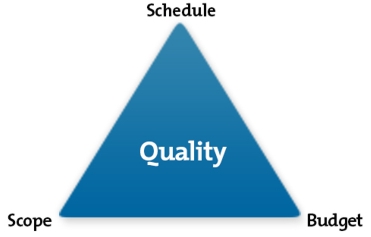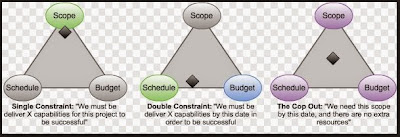Knowledge Areas
-
Knowledge areas
- Project Integration Management
- Project Scope Management
- Project Time Management
- Project Cost Management
- Project Quality Management
- Project Human Resources Management
- Project Communication Management
- Project Risk Management
- Project Procurement Management
-
Knowledge areas
- Project Integration Management
- Project Scope Management
- Project Time Management
- Project Cost Management
- Project Quality Management
- Project Human Resource Management
- Project Communications Management
- Project Risk Management
- Project Procurement Management
- Project Stakeholder Management
The processes that belong in each process group - Initiating, Planning, Executing, Monitoring & Control, and Closing, what they do and which knowledge area they represent can be confusing. This post (based on the info in PMBOK) discusses about each process group and briefly explains the processes that belong in each process group. The knowledge area they represent is indicated in brackets after the process. This post could serve as reference for project managers and also help someone preparing for PMP certification.
Initiating:
Processes performed to define a new project or a new phase of an existing project.
- Develop Project Charter (Integration): Process of developing a document that formally authorizes a project and documenting initial requirements that satisfy the stakeholders needs and expectations. Output: Project Charter
- Identify Stakeholders (Communication): Process of identifying all people or organizations impacted by the project and documenting relevant information regarding their interests, involvement and impact on project success. Outputs: Stakeholder register, Stakeholder management strategy
Planning:
Processes required to establish the scope of the project, refine the objectives and define the course of action required to attain the objectives of the project.
- Develop Project Management Plan (Integration): Process of documenting actions necessary to define, prepare, integrate and coordinate all subsidiary plans. Outputs: Project Management plan.
- Collect requirements (Scope): Process of defining and documenting stakeholders' needs to meet the project objectives. Outputs: Requirements documentation, requirements management plan and requirements traceability matrix
- Define scope (Scope): Process of developing a detailed description of the project and product. Outputs: Project scope statement, project document updates
- Create WBS (Scope): Process of subdividing project deliverables and project work into smaller, more manageable components. Outputs: WBS, WBS dictionary, scope baseline, project document updates (WBS - Work Breakdown Structure)
- Define activities (Time): Process of identifying the specific actions to be performed to produce the project deliverables. Outputs: Activity list, activity attributes, milestone list
- Sequence activities (Time): Process of identifying and documenting relationships among the project activities. Outputs: Project schedule network diagram, project document updates
- Estimate activity resources (Time): Process of estimating the type and quantities of material, people, equipment, or supplies required to perform each activity. Outputs: Activity resource requirements, resource breakdown structure, project document updates
- Estimate activity duration (Time): Process of approximating the number of work periods needed to complete individual activities with estimated resources.Outputs: Activity duration estimates, project document updates
- Develop Schedule (Time): Process of analyzing activity sequences, durations, resource requirements and schedule constraints to create the project schedule. Outputs: Project schedule, schedule baseline, schedule data, project document updates
- Estimate costs (Cost): Process of developing an approximation of the monetary resources needed to complete project activities. Outputs: Activity cost estimates, basis of estimates, project document updates
- Determine budget (Cost): Process of aggregating the estimated costs of individual activities or work packages to establish an authorized cost baseline.Outputs: Cost performance baseline, project funding requirements, project document updates
- Plan quality (Quality): Process of identifying quality requirements and/or standards of the project and product and documenting how the project will demonstrate compliance. Outputs: Quality management plan, quality metrics, quality checklists, process improvement plan, project document updates
- Develop Human Resource plan (Human Resource): Process of identifying and documenting project roles, responsibilities and required skills, reporting relationships and creating a staffing management plan. Output: Human Resource Plan
- Plan communications (Communication): Process of determining project stakeholder information needs and defining a communication approach.Outputs: Communication management plan, project document updates
- Plan risk management (Risk): Process of defining how to conduct risk management activities for a project. Output: Risk Management plan
- Identify Risks (Risk): Process of determining which risks may affect the project and documenting their characteristics. Output: Risk register
- Perform Qualitative risk analysis (Risk): Process of prioritizing risks for further analysis or action by assessing and combining their probability of occurrence and impact. Output: Risk register updates
- Perform Quantitative risk analysis (Risk): Process of numerically analyzing the effect of identified risks on overall project objectives. Output: Risk register updates
- Plan risk response (Risk): Process of developing options and actions to enhance opportunities and to reduce threats to project objectives. Outputs:Risk register updates, risk contract related decisions, project management plan updates, project document updates
- Plan procurements (Procurements): Process of documenting project purchasing decisions, specifying the approach and identifying potential sellers.Outputs: Procurements management plan, procurements statement of work, make-or-buy decisions, procurement documents, source selection criteria, change requests
Executing:
Processes performed to complete the work defined in project management plan to satisfy the project specifications.
- Direct & Manage project execution (Integration): Process of performing the work defined in the project management plan to achieve the project's objectives. Outputs: Deliverables, work performance information, change requests, project management plan updates, project document updates
- Acquire project team (Human Resource): Process of confirming human resource availability and obtaining the necessary team to complete project assignments. Outputs: Project staff assignments, resource calendars, project management plan updates
- Perform quality assurance (Quality): Process of auditing the quality requirements and the results from quality control measurements to ensure appropriate quality standards are used. Outputs: Organization process assets updates, change requests, project management plan updates, project document updates
- Develop project team (Human Resource): Process of improving the competencies, team interaction and the overall team environment to enhance project performance. Outputs: Team performance assessments, enterprise environmental factors updates
- Manage project team (Human Resource): Process of tracking team member performance, providing feedback, resolving issues and managing changes to optimize project performance. Outputs: Enterprise environmental factors updates, organization process assets updates, change requests, project management plan updates
- Distribute Information (Communication): Processing of making relevant information available to project stakeholders, as planned. Output:Organization process assets updates
- Manage stakeholder expectations (Communication): Process of communicating and working with stakeholders to meet their needs and addressing issues as they occur. Outputs: Organization process assets updates, change requests, project management plan updates, project document updates
- Conduct procurements (Procurements): Process of obtaining seller responses, selecting a seller and awarding a contract. Outputs: Selected sellers, procurement contract award, resource calendars, change requests, project management plan updates, project document updates
Monitoring & Controlling:
Processes required to track, review and regulate the progress and performance of the project.
- Monitor & Control project work (Integration): Process of tracking, reviewing and regulating the progress to meet the performance objectives defined in the project management plan. Outputs: Change requests, project management plan updates, project document updates
- Perform Integrated Change control (Integration): Process of reviewing all change requests, approving changes and managing changes to the deliverables, organization process assets, project documents and project management plan. Outputs: Change requests status updates, project management plan updates, project document updates
- Verify scope (Scope): Process of formalizing acceptance of the completed project deliverables. Outputs: Accepted deliverables, change requests, project document updates
- Control scope (Scope): Process of monitoring the status of the project and product scope and managing changes to the scope baseline. Outputs: Work performance measurements, organization process assets updates, change requests, project management plan updates, project document updates
- Control schedule (Time): Process of monitoring the status of the project to update project progress and managing changes to the schedule baseline.Outputs: Work performance measurements, organization process assets updates, change requests, project management plan updates, project document updates
- Control costs (Cost): Process of monitoring the status of the project to update the project budget and managing changes to the cost baseline.Outputs: Work performance measurements, budget forecasts, organization process assets updates, change requests, project management plan updates, project document updates
- Perform quality control (Quality): Process of monitoring and recording results of executing the quality activities to assess performance and recommend necessary changes. Outputs are quality control measurements, validated changes, validated deliverables, organization process assets updates, change requests, project management plan updates, project document updates
- Report performance (Communication): Process of collecting and distributing performance information including status reports, progress measurements and forecasts. Outputs: Performance reports, organization process assets updates, change requests
- Monitor and control risks (Risk): Process of implementing risk response plans, tracking identified risks, monitoring residual risks, identifying new risks and evaluating risk process effectiveness throughout the project. Outputs:Risk register updates, organization process assets updates, change requests, project management plan updates, project document updates
- Administer procurements (Procurements): Process of managing procurement relationships, monitoring contract performance and making changes/corrections as needed. Outputs: Procurement documentation, organization process assets updates, change requests, project management plan updates
Closing:
Process performed to finalize all activities across all process groups to formally close the project or phase.
- Close project or phase (Integration): Process of finalizing all activities across all of the project management process groups to formally complete the project or phase. Outputs: Final product, service or result transition, organization process assets updates
- Close procurements (Procurement): Process of completing each project procurement. Outputs : Closed procurements, organization process assets updates
The 5 process groups are listed below:
- Initiating: Begins with the project; Processes are performed in the Initiating process group to define a new project or a news phase of an existing project.
- Planning: Processes in the Planning group establish the scope of the project and define the course of action required to attain the project's objectives
- Executing: Processes in the Executing group are performed to complete the work as specified in the Project Management Plan
- Monitoring & Controlling: Processes track, review and regulate the progress and performance of the project.
- Closing: Ends the project; Processes are performed to formally the close the project or a phase.
------------------------------------------------------------------------------------------------------------------------
Iron Triangle shown with Single Constraint, Double Constraint
Iron Triangle shown with Single Constraint, Double Constraint
The Iron Triangle of Project Management
Balancing Your Budget, Scope, and Schedule
(Also known as The Triple Constraint of Project Management.)

Learn how to deliver projects within the "iron triangle."
You're managing the implementation of a new reporting system for your organization. As your project progresses, things happen differently from how you'd planned. You find that you need extra computer hardware, and some tasks have taken longer to complete than you originally predicted.
To get the tasks completed on time, you consider recruiting more contractors. But, to do this, you'd have to take other costs out of the project's budget. You think about not buying the extra computer hardware that you need, however, this would mean changing the project's scope, so that some functionality isn't delivered.
In many projects, the budget, scope and schedule are closely linked. Changes to one of these three key constraints will most likely affect the others, or impact on the quality of the project.
This article examines the relationship between the three constraints of budget, scope and schedule, and looks at ideas and tools for helping you deal with the issues that can affect this relationship.
The Iron Triangle
The project mandate and project charter identify the project's objectives. At the core of these documents is a requirements statement that says what the project needs to deliver. This includes a definition of what is in and out of scope for the project. It also establishes the project's deadlines and its budget.
These constraints of scope, budget, and schedule are known as the "iron triangle" (see figure 1).
Figure 1 – The Iron Triangle of Project Management

Original diagram in the article, "What is Project Management?" Reproduced with permission of the Association for Project Management.
These constraints are considered an iron triangle because you can rarely change one constraint without also impacting the others. The way that you deliver the project within these constraints impacts the quality of the project's outcomes, either positively or negatively.
For example, suppose your project mandate is to launch a new standalone IT system. The design phase has overrun significantly. You could consider several options:
--------------------------------------------------------------------
The demise of the Project Iron Triangle
The iron triangle was invented by Dr Martin Barnes in 1969 to demonstrate the connection between time, cost and output (correct scope at the correct quality) – see The Origins of Modern Project Management. The correlation remains but the concept of the triangle is fading and becoming more complex.
The problem with the triangle is whilst the three interconnections are relevant; the way the elements interact geometrically is not intuitive or correct. Output should react inversely to the other two dimensions. Less output is bad, but less time or cost is potentially good.
As we move into second decade of the 21st century, leaving the ‘noughties’ behind, PMI have dropped the concept of the iron triangle from the PMBOK® Guide and the search is on for more meaningful and unfortunately complex metaphors to define the challenges of satisfying a project’s stakeholders and customers by realising benefits. This is a multi-dimensional problem and there is a real need for a new paradigm similar to the iron triangle but representing the many different facets of success.
As Albert Einstein once said “For every complex question there is a simple and wrong solution.”And whilst the iron triangle was not intrinsically ‘wrong’ in the 70s, 80’s and possibly 90’s it is certainly incomplete in the complex world of the 2010s.
I have seen several attempts to replace the simplicity of the triangle with tetrahedrons and multi dimensional effort charts but they lack clarity of insight. Another quote from Einstein is “If you can’t explain it simply, you don’t understand it well enough.” The question and challenge is how to replace a project management icon as powerful as the ‘iron triangle’ with a more representative symbol.
What will be the new symbol of project management in the ‘teen years for the 21st century? Any ideas are welcome.
----------------------------------------
Single Constraint Deliver X capabilities for this project to be successful
Double Constraint Deliver X capabilities for this project by this date in order to be successful
Triple Constraint Deliver X capabilities for this project by this date and given resources- no extra resources
Constraints in a Project
If your schedule duration is decreased, then following in your Time, Cost ,Scope need to be adjusted as following
Time Decrease duration of project schedule will lead to one or both of following
Cost Need to increase
Scope Decrease the project scope
-------------------------------------
About the PMP Exam :
- Lot of Numericals on Cost management which are actually very easy to attempt. Practice a lot of questions. There is a PMP Mathematics sheet provided by Knowledge woods with all the formulas and sample questions. This will help in last time preparations.
- A lot of questions related to Project Charter.
- A lot of tricky questions. Look for key words- ALWAYS, NOT, EXCEPT, MUST etc.
- Followed Praveen Sir’s advice- DON’T ASSUME ANYTHING & READ THE QUESTION CAREFULLY.
- Be calm and patient during the exam- 1 question which I specifically remember. There was a very big network diagram of at least 25 activities and the question asked float on critical path. The answer is obvious if we don't jump to calculate it.
- The exam is not at all difficult if you clear your concepts.
- The Scordo and other sample test papers follow a lot of questions on Ethics, the exam had no such question but there is no harm in reading those 5-10 pages. I read it in Head first.
The Result :
Proficient in all process groups and Moderately Proficient in Closing Process group.
-------------------------------------







Thank you a lot for providing individuals with a very spectacular possibility to read critical reviews from this site.
ReplyDeleteProject Management